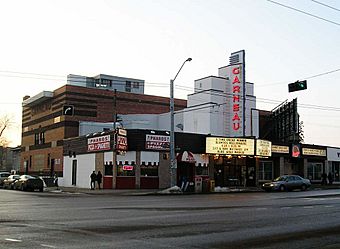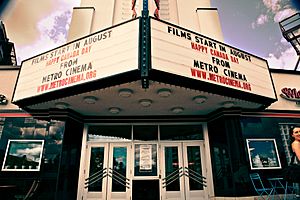Garneau Theatre facts for kids

The east face and main entrance of the theatre in 2009.
|
|
| Location | 8712 109 Street NW Edmonton, Alberta, Canada T6G 1E9 |
|---|---|
| Coordinates | 53°31′23″N 113°30′45″W / 53.52306°N 113.51250°W |
| Designation | Municipal Historic Resource |
| Capacity | 527 |
| Construction | |
| Years active | 1940–1990; 1991–present |
| Architect | William Blakey |
The Garneau Theatre is an old movie theater in Edmonton, Alberta, Canada. It's on 109 Street.
It started on its own, then joined a company called Famous Players in 1941. The theater closed in 1990 but reopened in December 1991. Magic Lantern Theatres took over and fixed it up in 1996. Magic Lantern ran the Garneau until June 2011.
In July 2011, the Garneau became the new home for Metro Cinema. It officially reopened in September 2011. The city of Edmonton named it a Municipal Historic Resource on October 28, 2009. This means it's an important historical building.
The Garneau was designed by William Blakey and built in 1940. It is the only movie theater left in Alberta from that early modern style.
Contents
History of the Garneau Theatre
How the Garneau Theatre Started
Walter Wilson was a movie theater manager in Winnipeg. He moved his family to Edmonton in 1928. There, he managed the Capitol Theatre. His son, Bill Wilson, worked as an usher for his dad. Later, Bill became an engineer for the government.
When Bill got married, he promised his wife he wouldn't work in movies again. But he lost his job in 1938. So, he started raising money for new movie theaters. His company, Suburban Theatres, opened its first theater, the Roxy, in 1938. The Garneau, his second theater, opened on October 24, 1940.
The Garneau was described as "Spacious, attractively designed and modern." The ticket booth was made of shiny vitrolite. The lobby had red tiles. The foyer had special furniture from a royal visit in 1939. Ushers wore red jackets and blue pants. They offered a free coat check and helped guests find their seats.
The projection room had special projectors. They made the movie picture very bright for that time. The theater had 780 seats. Some were red leather "two's company" seats without armrests. The Garneau was also built for live shows. It had a big stage with dressing rooms. Instead of a costly balcony, the architect William Blakey added a "climbing mezzanine." This was a clever way to save money.
Famous Players Takes Over
Famous Players leased the Garneau in 1941. This meant the theater could show popular new movies. Bill Wilson managed the Garneau for most of the time. He only left for two years to manage other theaters. Famous Players updated the theater in 1960. They put in bigger seats, which lowered the number of seats to 630.
Wilson stopped being manager in 1971. But he still owned the theater through his company. He ran his company from the Garneau's basement. He once said he had only seen two movies in eight years. Wilson passed away in January 1985.
Famous Players kept running the theater until late 1990. They decided not to renew their lease. By then, the Garneau was known for showing older, less exciting films. Bigger, newer movie theaters were becoming more popular.
Magic Lantern Theatres and Changes
Magic Lantern Theatres leased the Garneau and reopened it in December 1991. It became a discount theater for university students. In 1992, a developer wanted to change the theater into a bar and playhouse. This plan included dancing, basketball, and billiards.
Magic Lantern's president, Tom Hutchinson, found people to buy the theater. They wanted to keep it as a movie theater. The Garneau stayed open as a discount theater until 1996. Then, it was renovated and started showing new movies. More large seats were added, reducing the capacity to 527 seats.
In 2001, the University of Alberta wanted to buy the land the theater was on. This plan failed because the community was against it. It also would have cost too much money.
Local developer John Day bought the Garneau in 2007. He promised the theater would stay. In 2009, there were plans to add a second floor of businesses. These plans were stopped after people in the community disagreed. The City of Edmonton paid $547,000. In return, the theater agreed to look like it did in 1940. The city officially made it a Municipal Historic Resource in 2009.
Magic Lantern Theatres stopped running the Garneau in June 2011. They said the rent had gone up.
Metro Cinema Society Takes Over
Metro Cinema Society is a non-profit group in Edmonton. They took over the Garneau Theatre on July 1, 2011. The theater was closed for over two months for important repairs. One article mentioned the carpets were cleaned for the first time in a long time.
Metro officially reopened the Garneau on September 16, 2011. They promised new movies every day and special film festivals. The Garneau now hosts events every year. These include the Northwestfest documentary film festival. It also hosts the Rainbow Visions Film Festival for LGBTQ films.
Architecture and Design
Suburban Theatres hired William George Blakey to design the Garneau Theatre in the late 1930s. He also designed other buildings in Edmonton. These include Christ Church, the Masonic Temple, and the Roxy Theatre. The Garneau is the last modern-style theater still used for movies in Alberta.
Blakey's design saved money by using a raised terrace instead of a balcony. The lobby looked modern with curved walls. It had simple wooden doors and half-circle lights. The theater itself had bright colors. It featured hidden neon lights and dark blue walls. The chairs were blue, and the love seats were red. Gold highlights were around the stage opening.
Over the years, lights from other theaters were added to the Garneau. Today, the theater has lights from Edmonton's first Varscona Theatre. It also has lights from the Royal Theatre in Innisfail. Other lights came from the Grand Theatre in Melfort, Saskatchewan. Some lights are even from the Wilma Theatre in Coeur d'Alene, Idaho.





